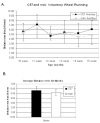Upregulation of the creatine synthetic pathway in skeletal muscles of mature mdx mice
- PMID: 17588756
- PMCID: PMC2706264
- DOI: 10.1016/j.nmd.2007.04.008
Upregulation of the creatine synthetic pathway in skeletal muscles of mature mdx mice
Abstract
Duchenne muscular dystrophy (DMD) is a fatal neuromuscular human disease caused by dystrophin deficiency. The mdx mouse lacks dystrophin protein, yet does not exhibit the debilitating DMD phenotype. Investigating compensatory mechanisms in the mdx mouse may shed new insights into modifying DMD pathogenesis. This study targets two metabolic genes, guanidinoacetate methyltransferase (GAMT) and arginine:glycine amidinotransferase (AGAT) which are required for creatine synthesis. We show that GAMT and AGAT mRNA are up-regulated 5.4- and 1.9-fold respectively in adult mdx muscle compared to C57. In addition, GAMT protein expression is up-regulated at least 2.5-fold in five different muscles of mdx vs. control. Furthermore, we find GAMT immunoreactivity in up to 80% of mature mdx muscle fibers in addition to small regenerating fibers and rare revertants; while GAMT immunoreactivity is equal to background levels in all muscle fibers of mature C57 mice. The up-regulation of the creatine synthetic pathway may help maintain muscle creatine levels and limit cellular energy failure in leaky mdx skeletal muscles. These results may help better understand the mild phenotype of the mdx mouse and may offer new treatment horizons for DMD.
Figures







References
-
- Koenig M, Hoffman EP, Bertelson CJ, Monaco AP, Feener C, Kunkel LM. Complete cloning of the Duchenne muscular dystrophy (DMD) cDNA and preliminary genomic organization of the DMD gene in normal and affected individuals. Cell. 1987;50:509–517. - PubMed
-
- Nonaka I. Animal models of muscular dystrophies. Lab Anim Sci. 1998;48:8–17. - PubMed
-
- Watchko JF, O’Day TL, Hoffman EP. Functional characteristics of dystrophic skeletal muscle: insights from animal models. J Appl Physiol. 2002;93:407–417. - PubMed
-
- McArdle A, Edwards RH, Jackson MJ. Time course of changes in plasma membrane permeability in the dystrophin-deficient mdx mouse. Muscle Nerve. 1994;17:1378–1384. - PubMed
Publication types
MeSH terms
Substances
Grants and funding
LinkOut - more resources
Full Text Sources

